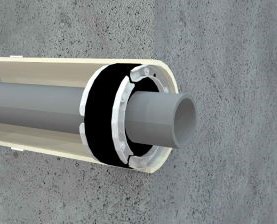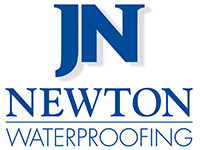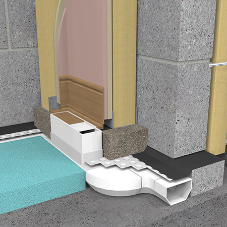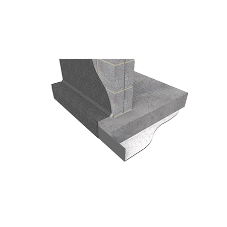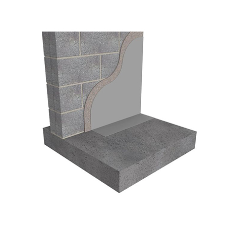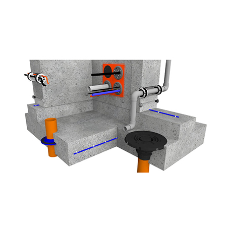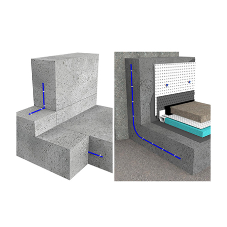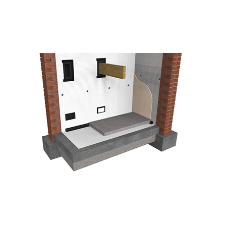To read the full news piece, click here.
Newton Waterproofing supply a variety of methods for sealing penetrations through below ground structures. As is usually the case with systems that resist ground water pressure, good forward planning and the use of products that have the required design performance is paramount.
Water has the potential to pass between pipes and cables within the sleeve but also between the sleeve and the concrete, and so the selection and method of waterproofing the sleeve is just as important as the method of waterproofing between the services within the sleeve.
Waterproofing Service Entry Sleeves
Cast-in-situ
If the number and location of the service sleeves is known, the sleeves can be positioned ready for the placement of the concrete.
The Hauff ZVR is a cement coated wall sleeve that reacts with the wet concrete to form a homogenous bond that is fully waterproof and gas proof. The sleeves are available in diameters from 50mm to 300mm and suitable for wall thickness from 180mm to 900mm. Each diameter is exact to tight tolerances ensuring that mechanical sealing systems details below are always correctly sized for optimum performance.
Core Drilled
Where service entry positions could not be determined before the concrete placement, the sleeve will need to be core-drilled.
Correct Sizing
With both cast-in-situ and core drilled sleeves, the optimum size of the sleeve is determined by the size and number of services passing through each sleeve. Each of the sealing methods detailed below have size and tolerance requirements. The Newton Technical Team can assist on the correct sizing for each method.
Modular Cable Entry System
Where multiple entries pass into the building in close proximity, the Hauff HSI system may be preferred, which are available in 150mm and 200mm internal diameters.
Service Entry Sealing Systems
Pre-planned
Where a Hauff Sleeve as detailed above has been installed, it is likely that the type of service and number of services passing though the sleeve is known and all that is required to complete the project is the correct selection of the Hauff Press Seal.
Mechanical Press Seals are by far the safest method of sealing service entry penetrations, and with a little planning, are guaranteed to always provide a long lasting, waterproof solution.
Press Seals are available in steel or polymer and in a variety of configurations, but in most cases the Standard Press Seals will be suitable. Split Seals all for installation is possible even when the pipes or cables are already passing through the sleeve.
Standard Press Seals for Pipe Entries
Standard Press Seals for Cable Entries
The conduit used to protect the cables within the ground should not pass through the service entry sleeve as an effective seal to corrugated or ribbed conduit cannot be guaranteed.
Unplanned or Failed Services
Where the service sleeve is already in place, or where the service entry is leaking and requires remediation, the Hauff Press Seals as detailed above will in most cases be the easiest and safest method of sealing the service entry.
There will be scenarios though where the Hauff Press Seal cannot be used such as:
Non-cylindrical sleeves such as letterbox openings or where a plastic pipe used as a sleeve has deformed
Where ribbed or corrugated conduit passes through the sleeve and cannot be removed
The internal diameter is not suitable
Where a mechanical press seal cannot be used a mastic or resin sealing systems are often the only options available. Newton are distributors of two leading mastic sealing systems, Stopaq and Filoseal, and the LeakPlug foaming resin system.
Stopaq
The main USP of Stopaq is that it is very effective at sealing leaking services.
There may be scenarios where Stopaq is used in conjunction with the other sealing systems due to its ability to control even heavy volumes of water ingress.
FiloSeal
Filoseal cannot be used where water is passing through the services but the FiloSeal +HD Fire variant has the advantage of being rated to up to 4 hours fire resistance.
It is also better suited to filling larger spaces between the sleeve and services due to the support provided by the hexagonal tubes.
LeakPlug
The LeakPlug Kit comprises of 0.5 kg of a PU foaming resin, 0.05 litres of catalyst and 40 g of polyester fibres. These all are mixed within a plastic bag to form a wad of material. Immersion in water activates the foaming action of the resin and the wad is pushed hard between the services to seal the leaks.
Sealing Penetrations Through Below Ground Structures
| T | 01732 496 512 |
|---|---|
| F | (01732) 359033 |
| E | tech@newtonwaterproofing.co.uk |
| W | Visit Newton Waterproofing Systems (John Newton & Company)'s website |
| Newton House, 17-19 Sovereign Way, Tonbridge, Kent, TN9 1RH |
Products by this Company


